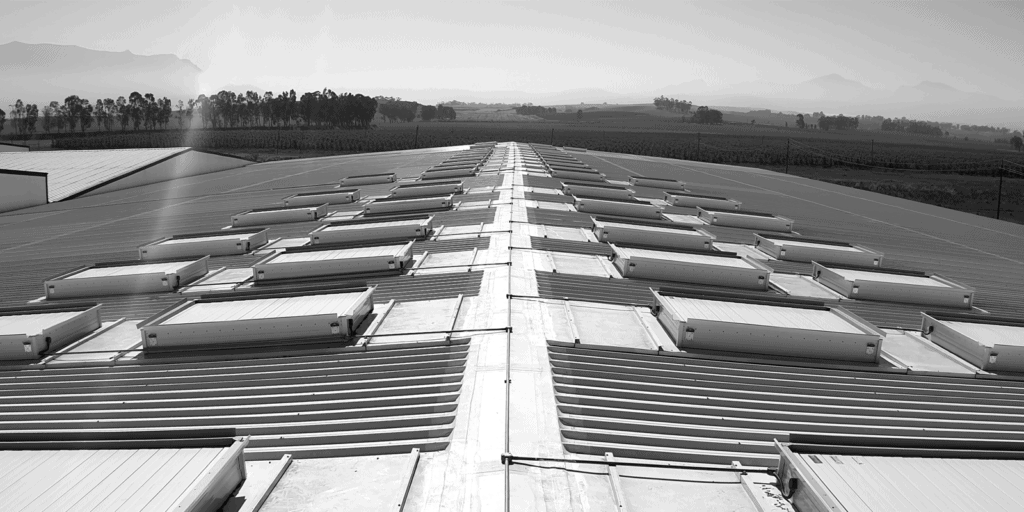Introduction
When it comes to building safety in South Africa, two critical codes play a pivotal role in ensuring the well-being of occupants and property protection. SANS 10400 Part T and EN 12101 lay the foundation for smoke control systems, but their significance goes beyond mere compliance. In this blog, we will discuss the importance of smoke control in buildings and shed light on why passive fire protection is indispensable within commercial buildings.
Why is Smoke Ventilation Necessary?
A well-designed Smoke and Heat Exhaust Ventilation System – SHEVS – should be able to maintain a smoke-free clear layer of at least 2,5m above the highest occupied space, thus providing escape conditions and allowing the building to be safely evacuated with minimum risk of smoke inhalation, injury or death.
When is Smoke Ventilation Compulsory?
- Any building with a floor area of over 500 m2 must be provided with smoke ventilation, this can be done with open-able windows, panels or other openings (Roof ventilators i.e. Slope ventilators or Louvred ventilators).
- The ventilator equipment must be located on the roof or in the upper third of the wall of the building.
- The openings must be equal to 3% of the floor area or in the case of a D2 or D3 classification (Moderate Risk and Light Risk Industrial) be equal to 1.5 % of the floor area.
- Any building above 2500 m2 fitted with a sprinkler system cannot be equipped with smoke ventilation equipment that works with a fusible link. (New SANS 10400 regulations).
The Importance of Smoke Control
1. Life Safety
The primary purpose of smoke control in commercial buildings is to safeguard human life. In the event of a fire, smoke can be more deadly than the flames themselves. Toxic fumes, reduced visibility, and heat can lead to panic, making it difficult for people to evacuate safely. Smoke control systems ensure that smoke is contained and expelled, creating a clearer escape path for occupants.
2. Egress Efficiency
Commercial buildings often house a large number of people, and the efficient evacuation of occupants is paramount during a fire emergency. Smoke control systems help maintain the integrity of exit routes, enabling a faster and safer evacuation.
3. Firefighters’ Safety
It’s not only the building’s occupants who benefit from smoke control; firefighters also depend on these systems. Smoke control helps maintain tenable conditions for rescue operations, allowing firefighters to do their job effectively and safely.
4. Property Protection
Beyond human life, commercial buildings often contain valuable assets and equipment. Smoke control helps minimize smoke damage, preserving property and reducing financial losses.
Why Passive Fire Protection Matters
1. Preventing the Spread of Fire
Passive fire protection encompasses the use of fire-resistant materials and structures in building design. This includes fire-resistant walls, doors, and floors. By compartmentalising fire and preventing its spread, passive fire protection provides valuable time for evacuation and firefighting.
2. Enhancing Structural Integrity
Fire can weaken the structural integrity of a building. Passive fire protection measures, such as fire-resistant building materials, help maintain the structural stability of a building during a fire, reducing the risk of structural collapse.
3. Reducing Fire and Smoke Damage
Passive fire protection measures not only help prevent the spread of fire but also reduce the damage caused by smoke. Fire-rated barriers and materials can limit the migration of smoke and hot gases, helping to contain the fire within a designated area.
4. Legal and Insurance Compliance
Compliance with passive fire protection standards is often a legal requirement in building codes and regulations. It is also a crucial factor for insurance coverage. Failing to meet these requirements can result in legal consequences and insurance-related issues.
Interplay Between Active and Passive Fire Protection
The synergy between active and passive fire protection mechanisms is indispensable in fostering a holistic fire safety paradigm. While active systems like SHEVS mitigate smoke hazards, passive systems contain and prevent fire spread, collectively enhancing the safety and protection of buildings.
Adherence to SANS 10400 Part T and EN 12101 Codes
In South Africa, these codes are the linchpins ensuring the effective implementation of smoke control systems. They underscore the quintessence of these systems for life safety, property protection, and firefighting operations efficiency in commercial buildings.
A well-functioning smoke control system can result in long-term savings by reducing fire-related damages, potentially lowering insurance premiums, and ensuring business continuity post a fire incident.
Conclusion
The discourse on smoke control and passive fire protection is not merely a compliance checklist but a critical discourse on safety in South African commercial buildings. By adhering to the stipulated codes and investing in these systems, stakeholders not only ensure compliance but significantly contribute to the safety and well-being of occupants.



